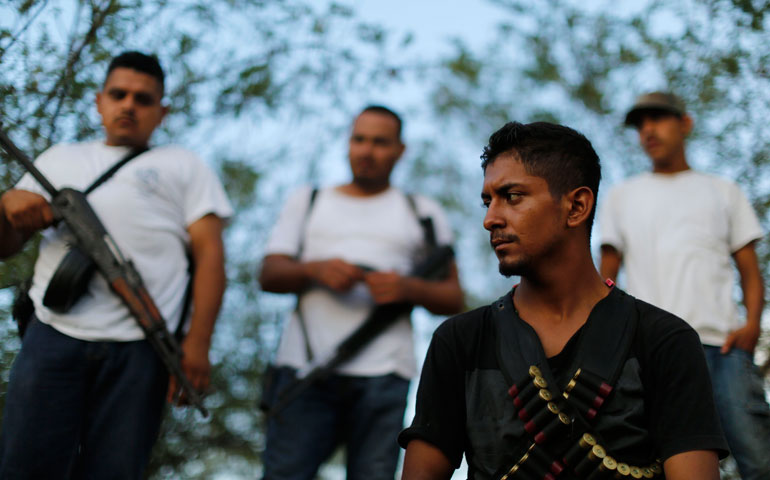
Vigilantes stand guard after hearing rumors of a possible ambush by drug cartels in Michoacán state, Mexico, in January 2013. (Reuters/Alan Ortega)
Editor's note: The following is Part 2 of 3 in a series focusing on gun violence in Mexico. Mexico is a state with highly restrictive gun laws, but is still inundated with firearms, most of them coming across the border from the United States. A March 2013 study by the Trans-Border Institute at the University of San Diego and the Brazil-based Igarapé Institute estimates that upward to a quarter million weapons purchased in the U.S. are smuggled into Mexico annually. Read part one of the series: US gun policy no longer domestic as weapons are smuggled to Mexico.
American guns and Mexican violence has been a recurring theme in U.S.-Mexico relations. During visits to the United States, Mexican officials have urged American lawmakers to resume the ban on assault weapons and support policies that inhibit cross-border arms trafficking, arguing that failure to do so has helped fuel violence in their homeland.
Those appeals have predictably evoked sharp criticism from the National Rifle Association, which accuses Mexico of displacing blame for a crisis that is homegrown and interfering with Americans' constitutionally protected right to own a gun.
Speaking at a Washington, D.C., forum on Mexican gun violence in the spring of 2012, former Mexican Ambassador to the United States Arturo Sarukhán called such criticism "gobbledygook. I am sure the founding fathers [of the United States] did not intend for international organized crime to source weapons in the U.S." The ambassador told his audience that after the U.S. ban on assault weapons was lifted, "long weapons" became the weapon of choice for Mexican drug cartels.
"Common shared responsibilities" is the oft-repeated phrase of Mexican and U.S. officials, but there has not been clear action backing up that rhetoric, said Pilar Tavera, director of Propuesta Civica (Civic Proposal) a Mexican human rights organization. "Because it is almost impossible to legally buy a gun in Mexico, illicit firearms are responsible for all the gun deaths," she said. "And it is the U.S. that is making this gun trafficking possible." Last fall, Tavera was among a group of Mexican activists who traveled to the U.S. with a photo exhibit of Mexican victims of gun violence that highlighted the consequences of U.S. gun policy for Mexican society.
Tavera agrees Mexico has a responsibility to prevent guns going south, just as the U.S. has a responsibility to prevent drugs going north, but she does not think it is worth getting "into a scenario of pointing fingers." She thinks a border-focused solution to Mexican violence is not possible because the problem is one of "law enforcement," which for Tavera means closing loopholes in U.S. gun law. By the time most weapons reach the border, there has already been a lot of abuse of the law, she noted. "Why try to prevent the river from flooding when it is already raining, when you can do so before the rain begins?"
US response
While eager to emphasize trade relations between the two countries, the Obama administration has not been indifferent to Mexico's gun concerns. President Barack Obama advocated for resumption of the assault weapons ban early in his first term and during a visit to Mexico last May acknowledged that most of the guns used to commit violence originate from the United States. "We'll keep increasing the pressure on the gun traffickers who bring illegal guns into Mexico," he said.
That pressure in the past included "Fast and Furious," the Bureau of Alcohol, Tobacco, Firearms and Explosives' botched 2009 operation to track gunrunners that resulted in ATF agents losing between 1,400-2,000 firearms. Half have since been recovered, including one used to kill a U.S. border agent.
In 2011, the federal government began requiring gun shops along the border states to report to the ATF whenever they sell more than one rifle within five consecutive business days to an unlicensed person. The multiple-sales reporting rule is narrow. Only sales of two or more .22 caliber semi-automatic rifles capable of accepting a detachable magazine merit documentation. Nonetheless, some U.S. lawmakers unsuccessfully sought to block the measure with a House amendment that denied federal funds for such reporting and a Senate bill that specifically prohibited the Department of Justice from "tracking and cataloguing the purchases of multiple rifles and shotguns."
Arms traffickers are reportedly adapting to the new scrutiny at the border by sending their straw purchasers to states farther north and buying smaller weapons with semi-automatic capacity.
The illicit flow of firearms is not exclusively an international problem. Illegal guns, smuggled across state borders, bedevil the streets of American communities as well. It's estimated that 85 percent of the crime weapons in New York, a state with fairly restrictive gun laws, originate elsewhere. So it is not surprising that of Obama's proposals to reform U.S. gun laws offered in 2013, measures to prevent arms trafficking had the most bipartisan support. Two bipartisan bills introduced in the U.S. Senate and House in January 2013 called for making arms trafficking and straw purchasing a federal crime with penalties of 20 years' imprisonment or longer, if the guns smuggled were linked to gangs, cartels or other criminal networks. Another proposal in the Senate specifically prohibited the illegal trafficking of guns outside the U.S.
U.S. Rep. Adam Schiff, a Democrat from the border state of California, has twice introduced a bill that would impose a mandatory two-year sentence on anyone convicted as a straw purchaser for weapons. A former federal prosecutor, Schiff says the current penalties -- "nothing more than a paper violation" -- are so insufficient that prosecutors won't prosecute. But Schiff's bill (H.R. 4190), like the legislative initiatives of January 2013, has yet to be enacted. It remains in the House Judiciary Committee, chaired for the past two years by Republicans with A ratings from the NRA.
Big business
Investigative journalist Bill Conroy doubts reforming U.S. gun law will significantly reduce the violence in Mexico. Conroy, who is based in San Antonio, reports on border issues and the Mexican drug war for the website The Narco News Bulletin. In a long email to NCR about U.S. arms trafficking in Mexico, he wrote that Mexicans "obviously ... don't like all the US guns flowing into their country, given the death toll from the drug war there is 120,000-plus and rising, and much of that is due to the availability of lethal US weapons."
But how those guns get into Mexico is a complex and multifaceted problem that Conroy thinks boils down to mercenary capitalism. "When you consider a gun bought in the US can easily sell for five times its value or greater in Mexico, you quickly realize it's a high-margin business, right up there with drugs itself," he wrote.
U.S. gun shops are only one of many tributaries supplying Mexico's gun pool, according to Conroy. In his email, he pointed out that "millions of dollars in munitions and weapons [are] imported annually to Mexico through 'legitimate' US government programs like the Direct Commercial Sales program." Overseen by the State Department, the program requires private U.S. arms manufacturers to obtain an export license before selling to foreign private or government buyers. Mexican law requires all arms imports to be vetted by the Ministry of Defense prior to being dispersed to their final destination -- the military, government law enforcement agencies, or private security companies. But Conroy said Mexico's military and law enforcement "are wracked with corruption and closely tied to organized crime -- in fact, are part of it in many cases. So weapons diversion is another issue."
The issue of diversion was the subject of a "sensitive" cable uncovered by Wikileaks, dated June 4, 2009. In it, the State Department asks Mexico how an AR-15, intended for the police or military, ended up in a criminal stash in a region wracked by violence. "Please account for the current location of the 1,030 AR-15 type rifles," reads the cable. There is no response from Mexico on record.
Whatever leverage the State Department had over the sale of legal weapons to Mexico is likely to diminish due to the Obama administration's recent reforms of arms export requirements, says William Hartung, director of the Common Defense Campaign: Arms and Security Project at the Center for International Policy in Washington, D.C. A central feature of the reform entails moving various categories of weapons and weapons-related technology, scheduled for export, from a list monitored by the State Department to the less scrutinized Commerce Control List. The U.S. government hasn't decontrolled small arms yet, Hartung said. But when they do, "it will make it easier to export guns to Mexico. The de-control of export regulations will also make it easier to sell guns to third parties, e.g., front companies in Bulgaria or Austria who then sell weapons to Iran or cartels in Mexico. If the State Department isn't vetting the end users, gun smugglers will have an easier time."
Conroy has long argued that legal U.S. arms exports may be the most significant source of narco-syndicates' firepower. In an April 14, 2011, Narco News article analyzing U.S. arms exports to Mexico from private manufacturers, Conroy noted that Mexico's sharp escalation in "narco-trafficking-related homicides" coincided with an increase in Mexican orders for U.S. weapons and Mexico's then-President Felipe Calderón's decision to militarize his campaign against the drug trade.
Conroy lists U.S. guns dumped on the Mexican black market from the ATF's Operation Fast and Furious as another contributor to Mexico's weapons pool, along with international arms dealers who "are more than willing to supply weapons illegally considering the profit margins involved."
"As long as you militarize the drug war, you are going to make the possession of guns lucrative," Conroy said. "I know that people who are anti-gun have the idea that if we have strict gun laws it will solve the problem [of Mexico's hyper-violence]. But I don't think this is a problem of passing laws unless you deal with the bad policy of waging a war on drugs. Guns and money go south and drugs go north. It is a multibillion-dollar business. If people want to get serious about solving that problem, then we can deal with the violence."
Molly Molloy, a border specialist and librarian at the University of New Mexico in Las Cruces, N.M., also doubts the value of tightening U.S. gun law to reduce the violence in Mexico. No fan of the NRA, Molloy thinks such an approach is naive, given the power of the U.S. gun lobby. It also underestimates the indigenous factors fueling Mexican violence: the high desertion rate among members of the Mexican military who take their guns with them; the war litter left over from decades of U.S. military intervention in the region; the corrupt alliances between state and criminal actors; and Mexico's dysfunctional criminal justice system.
Molloy said that in 2010, a year of extreme violence in Mexico, 3,000 people were killed in Juárez, a city with strict gun control, while only seven people were murdered in adjacent El Paso, an American city of lax gun laws. That disparity can only be attributed to Mexico's high rate of impunity, Molloy says. The impunity rate is "about 98 percent, which means only 2 percent of crimes are investigated and prosecuted," she said.
[Claire Schaeffer-Duffy is a longtime NCR contributor.]


